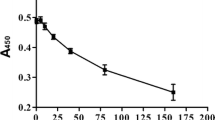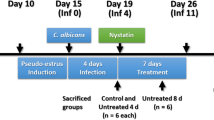Abstract
Benzydamine is a non-steroidal antiinflammatory drug, devoid of activity on arachidonic acid metabolism, which is extensively used as a topical drug in inflammatory conditions, particularly for the treatment of bacterial vaginosis andCandida albicans-sustained vaginitis. In the present study the effects of benzydamine on the production of several inflammatory cytokines were examined in cultures ofCandida albicans-stimulated human mononuclear cells. Benzydamine (6.25-50 ΜM) inhibitedCandida-induced tumor necrosis factor-α and, to a lesser extent, interleukin-1 Β production, whereas it did not affect interleukin-6 release. Benzydamine also blocked monocyte chemotactic protein-1 secretion, but it did not affect interleukin-8 production. Unlike benzydamine, ibuprofen and naproxen, two non-steroidal antiinflammatory drugs also used topically, were unable to suppress inflammatory lymphokine production fromCandida-activated mononuclear cells. These data suggesrthat benzydamine may be effective in localCandida infections at least in part by suppressing inflammatory cytokine and monokine production in the vaginal mucosa and consequently decreasing their levels in vaginal secretions.
Similar content being viewed by others
References
Cioli V, Corradino C, Scorza Barcellona P. Review of pharmacological data on benzydamine. Int J Tissue React 1985; 7: 205.
Mahon WA, De Gregorio M. Benzydamine: a critical review of clinical data. Int J Tissue React 1985; 7:229.
Bremond A. Clinical evaluation of benzydamine for treatment of vaginitis: results of a randomized study with emphasis on functional symptoms. Int J Tissue React 1987; 9:147.
Jensen J, Warner T, Balish E. Resistance of SCID mice toC. albicans administered intravenously or colonizing the gut: role of polymorphonuclear leukocytes and macrophages. J Infect Dis 1993; 167:912.
Svensson U, Holst E, Sundler R. Protein-kinase-C-independent activation of arachidonate release and prostaglandin E2 formation in macrophages interacting with certain bacteria. Eur J Biochem 1991; 200:699.
Djeu JY, Blanchard DK, Halkias D, Friedman H. Growth inhibition ofCandida albicans by human polymorphonuclear neutrophils: activation by interferon-α and tumor necrosis factor. J Immunol 1986; 137:2980.
Cassone A, Conti S, De Bernardis F, Polonelli L. Antibodies, killer toxins and antifungal immunoprotection: a lesson from nature? Immunol Today. In press.
Romani L, Mencacci A, Cenci E, Spaccapelo R, Toniatti C, Puccetti P, Bistoni F, Poli V. Impaired neutrophil response and CD4+T helper cell 1 development in interleukin 6-deficient mice infected withCandida albicans. J Exp Med 1996; 183:1345.
Garner ER, Rubanovice K, Sawyer RT, Hudson JA. Secretion of TNFαby alveolar macrophages in response toCandida albicans mannan. J Leukoc Biol 1994; 55:161.
Sironi M, Pozzi P, Polentarutti N, Benigni F, Coletta I, Guglielmotti A, Milanese C, Ghezzi P, Vecchi A, Pinza M, Mantovani A. Inhibition of inflammatory cytokine production and protection against endotoxin toxicity by benzydamine. Cytokine 1996; 8:710.
Marconi P, Scaringi L, Tissi L, Boccanera M, Bistoni F, Bonmassar E, Cassone A. Induction of natural killer activity by inactivatedCandida albicans in mice. Infect Immun 1985; 50:297.
Djeu JY, Blanchard DK, Richards AL, Friedman H. Tumor necrosis factor induction byCandida albicans from human natural killer cells and monocytes. J Immunol 1988; 141:4047.
Sironi M, Breviario F, Proserpio P, Biondi A, Vecchi A, Van Damme J, Dejana E, Mantovani A. IL-1 stimulates IL-6 production in endothelial cells. J Immunol 1989; 142:549.
Peri G, Milanese C, Matteucci C, Ruco L, Zhou D, Sozzani S, Coletta I, Mantovani A. A new monoclonal antibody (5D3-F7) which recognizes human monocyte-chemotactic protein-1 but not related chemokines. Development of a sandwich ELIS A and in situ detection of producing cells. J Immunol Methods 1994; 174:249.
Bernasconi S, Cinque P, Peri G, Sozzani S, Crociati A, Lazzarin A, Poli G, Mantovani A. Selective elevation of monocyte chemotactic protein-1 (MCP-1) in the cerebrospinal fluid of AIDS patients with cytomegalovirus encephalitis. J Infect Dis. 1996; 174:1098.
Oppenheim JJ, Zachariae CO, Mukaida N, Matsushima K. Properties of the novel proinflammatory supergene “intercrine” cytokine family. Annu Rev Immunol 1991; 9:617.
Sobel J. Genital candidiasis. In: Holmes KK et al., eds. Sexually transmitted diseases. New York: McGraw-Hill; 1990.
Author information
Authors and Affiliations
Rights and permissions
About this article
Cite this article
Sironi, M., Milanese, C., Vecchi, A. et al. Benzydamine inhibits the release of tumor necrosis factor-α and monocyte chemotactic protein-1 byCandida albicans-stimulated human peripheral blood cells. Int J Clin Lab Res 27, 118–122 (1997). https://doi.org/10.1007/BF02912445
Received:
Accepted:
Issue Date:
DOI: https://doi.org/10.1007/BF02912445




